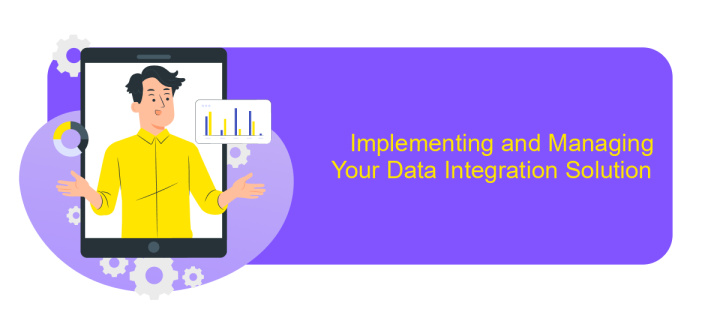Data Integration for Large Companies
In today's fast-paced business environment, large companies face the challenge of managing vast amounts of data from diverse sources. Data integration has become a crucial strategy for unifying this information, enabling organizations to streamline operations, enhance decision-making, and gain a competitive edge. By effectively merging data from various departments and systems, companies can achieve a holistic view of their operations, driving innovation and efficiency.
Understanding the Challenges of Data Integration in Large Enterprises
Data integration in large enterprises is a complex process that involves merging data from various sources to provide a unified view. This task is fraught with challenges that can hinder effective decision-making and operational efficiency. Understanding these challenges is crucial for developing robust integration strategies.
- Data Silos: Large companies often have data stored in isolated silos, making it difficult to access and integrate information across departments.
- Data Quality: Inconsistent or inaccurate data can lead to flawed insights, affecting business outcomes.
- Scalability: As companies grow, the volume of data increases, requiring scalable solutions to handle the data efficiently.
- Security and Compliance: Ensuring data security and compliance with regulations is critical, especially when integrating sensitive information.
- Technological Complexity: Integrating diverse technologies and platforms can be technically challenging.
Addressing these challenges requires a strategic approach, involving the adoption of advanced tools and technologies, as well as fostering collaboration across departments. By understanding and tackling these issues, large enterprises can achieve seamless data integration, leading to improved business intelligence and operational excellence.
Key Considerations for Large-Scale Data Integration

When undertaking large-scale data integration, organizations must prioritize data quality and consistency. Ensuring that data is accurate and standardized across various sources is critical for effective integration. Companies should implement robust data governance frameworks to manage data quality, addressing issues such as duplicate records, missing values, and conflicting data formats. Additionally, scalability is a key consideration; the integration solution must efficiently handle increasing volumes of data without compromising performance. Employing cloud-based platforms can offer the necessary scalability and flexibility to support growing data needs.
Another crucial factor is the selection of appropriate integration tools and services. For instance, leveraging platforms like ApiX-Drive can streamline the integration process by providing pre-built connectors and automation features, reducing the need for manual coding. Security and compliance are also paramount, especially for companies handling sensitive information. Organizations must ensure that their integration processes adhere to relevant data protection regulations and implement robust security measures to safeguard data. Finally, fostering collaboration between IT and business units can enhance the integration strategy, ensuring that it aligns with organizational goals and delivers value across the enterprise.
Choosing the Right Data Integration Approach

Choosing the right data integration approach is crucial for large companies seeking to optimize their data management processes. The decision-making process involves evaluating various factors such as data volume, complexity, and business needs. A well-chosen integration strategy can enhance data accessibility, improve decision-making, and ensure data consistency across the organization.
- Identify Business Requirements: Understand the specific data needs and objectives of your organization to align the integration approach with business goals.
- Evaluate Integration Methods: Consider different methods such as ETL (Extract, Transform, Load), ELT (Extract, Load, Transform), and data virtualization to determine which best suits your data landscape.
- Assess Scalability and Flexibility: Ensure the chosen approach can handle growing data volumes and adapt to future technological changes.
- Consider Data Security and Compliance: Prioritize approaches that offer robust security measures and comply with industry regulations.
By carefully analyzing these factors, large companies can select a data integration approach that not only meets their current needs but also supports future growth and innovation. This strategic decision is essential for maintaining a competitive edge and leveraging data as a valuable asset.
Implementing and Managing Your Data Integration Solution

Implementing a data integration solution in large companies requires a strategic approach to ensure seamless connectivity across diverse systems. Begin by conducting a thorough assessment of existing data sources and integration requirements. This initial step is crucial for identifying potential challenges and opportunities for optimization.
Once the assessment is complete, select appropriate integration tools and platforms that align with your company's needs. Consider scalability, compatibility, and ease of use when making your choice. Collaboration between IT and business departments is essential to ensure that the solution addresses both technical and operational objectives.
- Define clear data governance policies to maintain data quality and security.
- Establish a central data repository to streamline data access and management.
- Implement automated data workflows to enhance efficiency and reduce manual intervention.
- Regularly monitor and update the integration system to adapt to evolving business needs.
Managing the data integration solution involves continuous evaluation and optimization. Regular training sessions for staff can enhance system utilization and foster a data-driven culture. By prioritizing these elements, companies can achieve a robust and agile integration framework that supports their long-term strategic goals.
- Automate the work of an online store or landing
- Empower through integration
- Don't spend money on programmers and integrators
- Save time by automating routine tasks
Future Trends in Data Integration for Large Companies
As large companies continue to evolve in the digital era, data integration is set to become increasingly sophisticated. One emerging trend is the use of artificial intelligence and machine learning to automate data integration processes. These technologies can enhance data accuracy and reduce manual intervention, allowing companies to streamline their operations and make more informed decisions. Additionally, the growing importance of real-time data processing will push companies to adopt more advanced integration platforms that can handle large volumes of data efficiently and securely.
Another significant trend is the rise of low-code and no-code integration tools, which enable users with minimal technical expertise to set up and manage data integrations. Services like ApiX-Drive are at the forefront of this movement, offering intuitive platforms that simplify the integration process. This democratization of data integration allows businesses to be more agile and responsive to market changes. As a result, companies can focus on leveraging their data assets to drive innovation and maintain a competitive edge in an increasingly data-driven world.
FAQ
What is data integration, and why is it important for large companies?
What are the common challenges faced in data integration for large companies?
How can large companies ensure data quality during integration?
What role does automation play in data integration?
How can large companies manage data integration in a cost-effective manner?
Apix-Drive will help optimize business processes, save you from a lot of routine tasks and unnecessary costs for automation, attracting additional specialists. Try setting up a free test connection with ApiX-Drive and see for yourself. Now you have to think about where to invest the freed time and money!


